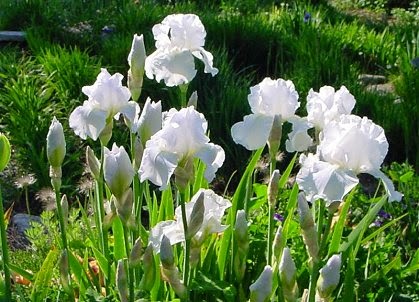by Betty Wilkerson
Zone 6
If you hang around iris groups, either in the flesh-and-blood world of local societies and rhizome sales in your local neighborhoods, or in the virtual world like the Reblooming Iris page on Facebook, you know that a common question is "how can I tell if an iris is technically a rebloomer?" Sometimes irises bloom in the summer, sometimes in the fall, but not the following spring, and so on, hence the question.
The AIS Judges Handbook is a bit more "loose." In summary, it states that rebloom should produce enough additional bloomstalks to double the total number of days of bloom produced annually (143).
I must admit, I have a loose definition: I like iris blooms so much that I welcome just about anything that puts up an extra bloom stalk.
My hybridizing lines were originally started with 'Feed Back', 'Immortality', 'Early of Essex' and a few others that rebloomed in fall.
After about 20 years I decided to work for summer bloom, and to stop working with most of the fall cycle rebloomers, since the fall bloomers often freeze here.
Some people are really fussy about their rebloomers and insist that they follow strict rules. For those, we have the definition from The World of Irises written by members of The American Iris Society, edited by Bee Warburton with Melba Hamblen as Assistant Editor, and with help from Dr. Raymond Smith. Dr. Smith wrote that "a rebloomer may be defined as any iris that produces an extra period of full bloom each year. By full bloom is meant bloom of one or more increases from each rhizome that flowered during the immediately preceding regular period. This definition excludes those sorts whose stalks emerge serially over an extended season, as well as clones with only a fraction of the mature rhizomes blooming during one period and the remainder during the next, even though such sorts do provide color apart from regular seasons and are frequently mislabeled rebloomers" (Warburton: 137).
The AIS Judges Handbook is a bit more "loose." In summary, it states that rebloom should produce enough additional bloomstalks to double the total number of days of bloom produced annually (143).
1. Rebloomers (Cyclic Rebloomers), the standard for this group, are cultivars which complete two distinct cycles of bloom. After the spring flowering, there is a second nearly predictable period of bloom.
2. Multiple Blooming Irises send up bloomstalks repeatedly at any time throughout the growing season, spring to summer and fall.
3. Repeaters produce additional bloomstalks with unpredictable regularity immediately following or shortly thereafter the initial Spring bloom season. It is not uncommon for these varieties to extend the spring bloom season from four to eight weeks.
4. Sporadic Rebloomers are varieties which unpredictably produce bloomstalks at varying times during the growing season. Many occasional rebloomers perform well on the West coast and the Southern areas of the United States. While they are highly regarded there, they may not show reblooming tendencies in colder climates.
5. Secondary Stalk Rebloomers, although rare, occur when rhizomes send up secondary stalks in the same growing season.
2. Multiple Blooming Irises send up bloomstalks repeatedly at any time throughout the growing season, spring to summer and fall.
3. Repeaters produce additional bloomstalks with unpredictable regularity immediately following or shortly thereafter the initial Spring bloom season. It is not uncommon for these varieties to extend the spring bloom season from four to eight weeks.
4. Sporadic Rebloomers are varieties which unpredictably produce bloomstalks at varying times during the growing season. Many occasional rebloomers perform well on the West coast and the Southern areas of the United States. While they are highly regarded there, they may not show reblooming tendencies in colder climates.
5. Secondary Stalk Rebloomers, although rare, occur when rhizomes send up secondary stalks in the same growing season.
I must admit, I have a loose definition: I like iris blooms so much that I welcome just about anything that puts up an extra bloom stalk.
My hybridizing lines were originally started with 'Feed Back', 'Immortality', 'Early of Essex' and a few others that rebloomed in fall.
 |
| 'Immortality' c. Terry Laurin |
| 'Earl of Essex' c. Lloyd Zurbrigg |
| 'Feedback' |
'Another Bridge'
'Stargate'
If you have any subjects or questions on rebloomers you would like to see addressed, please email me at bridgeintime@aol.com.








































.jpg)












